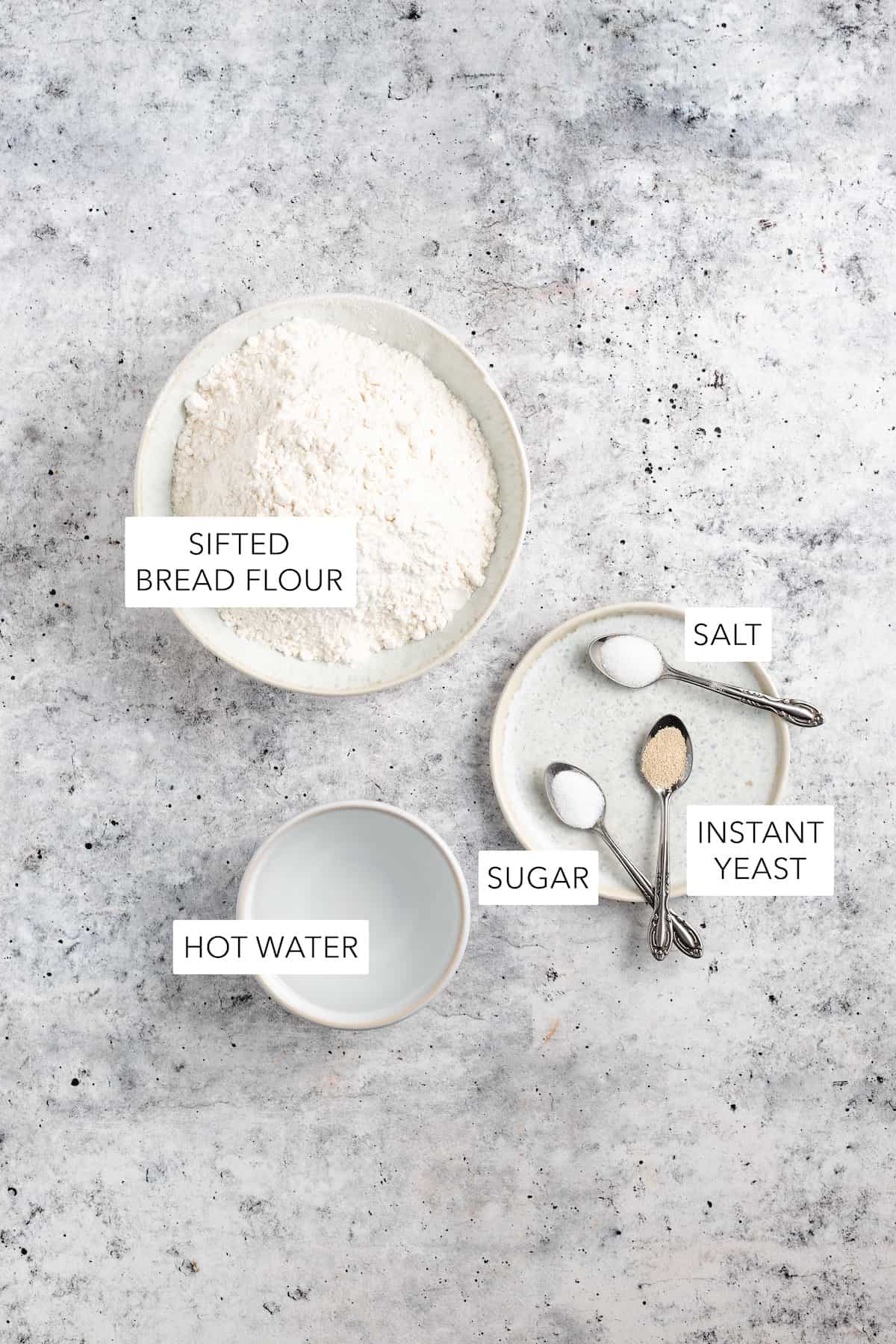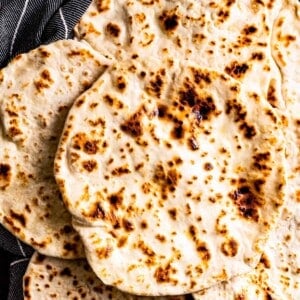This post may contain affiliate links. Please read our disclosure policy.
Wonderfully soft and delicious, lavash bread is the perfect blank canvas for all your spiced Mediterranean and Middle Eastern dishes. Simple yet homey and flavorful, and made with only six ingredients, lavash will be on your table and served with your favorite spiced foods in no time.
This recipe is great with sides like stuffed grape leaves and mains like chicken marbella or lamb. I love it with a bulgur salad and shredded leftover easy baked chicken breasts to make tasty tacos.

Lavash is a traditional soft, thin flatbread made with pantry staples, it’s the perfect flatbread recipe to add a bit of tradition to your meals. Best of all, it doesn’t have to feel like a whole bread-making adventure. Packed with cheats for an incredibly smooth dough and extra flavor, this lavash bread recipe might be your entryway to homemade flatbreads.
Easily prepared in advance and frozen, keeping a batch in your freezer for later will be a lifesaver—especially on hectic days. After seeing how nicely soft and bendy it is, you’ll never return to store-bought pita bread again. It’s so good that my daughter Aleksandra eats it as-is, without dips or sides. She tears it up in half and bites right into it.

What Is Lavash Bread?
Lavash is a flatbread, just like naan or pita bread, originating from Armenia and popular throughout the South Caucasus, Western Asia, and the Middle East. It’s typically made in a “tandoor,” a traditional cylindrical clay and mud oven where the breads are stuck to the walls for baking. Lavash bread is soft and can be folded easily to make sandwiches and wraps. It is also less doughy and chewy than, say, tortillas and pita breads.

What You’ll Need
The ingredients for this lavash recipe are simple: flour, water, yeast, sugar, and salt. Depending on the region, different aromatics and spices can be added to give it extra flavor. For the most part, however, this bread is relatively plain because it’s supposed to be paired with spiced Mediterranean and Middle Eastern foods.
- Bread flour – All-purpose flour works, too, but bread flour contains more protein, which helps develop more gluten. Gluten gives the dough its elasticity, which is needed to achieve that chewy texture.
- Salt – Flavors the dough.
- Granulated sugar – A teaspoon of honey is also okay, but please don’t use brown sugar.
- Instant yeast – Active dry yeast works too.
- Water – You can also substitute half of the water with whole milk.
- Cooking spray – Prevents sticking.
How to Make Lavash Bread
Making Armenian lavash is like a cross between bread and tortillas. The dough is rolled out thinly so that, as it cooks, it puffs up without becoming too dense. It’s served warm as a side dish and is even used to wrap all sorts of food in a naan or taco-like fashion.








- Make the dough. Add all the ingredients (except the cooking spray) to a large mixing bowl. Stir everything together using a wooden spoon. Once you get a loose dough, remove it from the bowl and place it on a lightly floured surface.
- Knead it. Knead the dough, pressing it away from you and then rolling it back in, for 7-12 minutes or until nice and smooth. If the dough is sticking to the counter too much, add 1 teaspoon of extra flour at a time until it’s no longer sticky.
- Let it rest. Roll the dough into a ball. If you press your finger into it, it should bounce back. Place it in a large bowl and cover it with a clean kitchen towel or plastic wrap. Let it rest in a warm spot for 1-2 hours or until doubled in size.
- Portion it. Remove it from the bowl and place the dough on a lightly floured surface. Section the dough into 6-8 even pieces. The more pieces, the smaller your lavash will turn out. Roll each piece into a ball. Cover them with a clean kitchen towel.
- Flatten it. Use a floured rolling pin to flatten them out into large circles. They should be thin, like tortillas or pasta. The thinner each lavash is, the more pliable it will be once cooked. Thicker lavash bread is just as yummy but they don’t fold well and take longer to cook.
- Cook it. Heat a medium pan over medium heat. Lightly grease it with cooking spray. Place one lavash in the pan at a time. Let them cook for 16-25 seconds on each side, or until lightly golden. Don’t let them burn.
- Serve. Remove them from the heat immediately and serve them warm.

Recipe Tips And Variations
- Speed up the process. If your dough isn’t rising, make sure it’s in a heat-proof bowl. Then preheat the oven to 200˚F for 10 minutes and turn it off. Place the bowl inside (make sure it’s not covered in plastic wrap) and let it rise with the residual heat. It should be ready within 20 to 40 minutes.
- Use hot water. This is often swapped for cold or room-temperature water, but I don’t recommend it. The dough will be stiff, not supple. Always use hot water if you want to avoid any issues with the dough.
- Don’t use unrisen dough. Never try to work with unrisen dough. The weather won’t always be in your favor, but just be patient and let the dough rise. If it hasn’t risen, your bread will be stiff.
- Check the yeast. Always check the expiration date on your yeast unless you want to spend hours waiting for a dough that’ll never rise.
- Add more flavor. Lightly brush the uncooked lavash with olive oil and sprinkle each bread with 1/2 tablespoon of finely chopped garlic and parsley on both sides. Cook them as usual.
- Use whole-wheat. Whole wheat flour will make your flatbread healthier and give it an earthier flavor.
- Add milk. Swapping the water for milk will give you a much richer flavor.
Serving Suggestions
This versatile lavash bread is used to wrap kebapi, make wraps, or as an accompaniment to a variety of dips and spreads such as hummus, ajvar, and baba ganoush.
You can also pair pita bread with my spinach artichoke chicken breasts, this other artichoke chicken, and classic baked chicken pieces.
For salad options, you have to make this tabbouleh. But also try my spring vegetable potato salad, avocado salad, and my fave olives and avocado salad with tomatoes and feta.

How to Store
- At room temperature: place them in paper bag for up to 2 days or in a paper towel-lined airtight container for up to 3 days.
- Fridge or Freezer: Keep them in an airtight container for up to a week or freeze them for up to 6 months. Thaw them overnight in the fridge before reheating.
- Reheat: Place the lavash on a warm griddle or skillet for 1 to 2 minutes on each side or until soft and pliable again.
More Homemade Bread Recipes
- No Knead Skillet Olive Bread
- Rosemary and Garlic No-Knead Skillet Bread
- Whole Wheat Banana Bread with Coconut Oil
- Slow Cooker Basil Pesto Bread
- Whole Wheat Focaccia Bread
Pin this now to find it later
Pin It
Lavash Bread
Ingredients
- 2¼ cups bread flour, sifted, plus more for dusting your work area
- ¾ teaspoon salt
- ½ teaspoon granulated sugar
- ¾ teaspoon instant yeast
- ¾ cup hot water
- cooking spray or olive oil, for greasing the pan
Instructions
- Whisk together the bread flour, salt, sugar, and yeast in a large mixing bowl. Add the hot water and stir everything together using a wooden spoon.
- Once you get a loose dough, remove it from the bowl and place it on a lightly floured surface.
- Knead the dough, pressing it away from you and then rolling it back in for 7 to 12 minutes or until nice and smooth.
- Roll the dough into a ball. Place it in a large bowl and cover it with a clean kitchen towel or plastic wrap. Let it rest in a warm spot for 1 to 2 hours or until doubled in size.
- Remove it from the bowl and place the dough on a lightly floured surface. Section the dough into 6 to 8 even pieces. The more pieces, the smaller your lavash will turn out.
- Roll each piece of dough into a ball. Cover them with a clean kitchen towel.
- Then, working with one dough ball at a time, flatten them out into large circles using a floured rolling pin. They should be thin, like tortillas.
- Heat a medium pan over medium heat. Lightly grease it with cooking spray. Place one lavash in the pan at a time. Let them cook for 15 to 25 seconds on each side or until lightly golden.
- Remove them from the skillet and keep covered while cooking the rest.
- Serve warm.
Equipment
Notes
- Kneading: Traditionally, kneading the dough by hand is the way to make authentic Lavash, but you can also use your mixer. Kneading in a mixer for 2 minutes is equivalent to kneading for about 10 minutes by hand. When finished kneading, the dough should feel supple and soft but not sticky.
- Dough: Let the dough rise. If it hasn’t risen, the bread will be stiff. Also, always keep the dough balls covered while rolling out the rest.
- When the lavash is cooked, transfer it to a plate and keep them covered while working with the rest.
- Flavor: Add more flavor by lightly brushing the uncooked lavash with olive oil and sprinkling it with minced garlic and parsley.
- Whole Wheat Flour: You can use whole wheat flour, but use 50 percent whole-wheat and 50 percent bread flour to avoid a dense result.
Nutrition
Nutritional info is an estimate and provided as courtesy. Values may vary according to the ingredients and tools used. Please use your preferred nutritional calculator for more detailed info.









Can they be frozen?
Yes, you can freeze them for up to 6 months. Thaw them overnight in the fridge before reheating.
Trying your hardest not mention IRAN
No, that’s not true at all. My apologies; I don’t mean to offend anyone. I only have so much space to explain everything I can about the recipe.